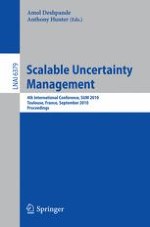Managing uncertainty and inconsistency has been extensively explored in - ti?cial Intelligence over a number of years. Now with the advent of massive amounts of data and knowledge from distributed heterogeneous,and potentially con?icting, sources, there is interest in developing and applying formalisms for uncertainty andinconsistency widelyin systems that need to better managethis data and knowledge. The annual International Conference on Scalable Uncertainty Management (SUM) has grown out of this wide-ranging interest in managing uncertainty and inconsistency in databases, the Web, the Semantic Web, and AI. It aims at bringing together all those interested in the management of large volumes of uncertainty and inconsistency, irrespective of whether they are in databases,the Web, the Semantic Web, or in AI, as well as in other areas such as information retrieval, risk analysis, and computer vision, where signi?cant computational - forts are needed. After a promising First International Conference on Scalable Uncertainty Management was held in Washington DC, USA in 2007, the c- ference series has been successfully held in Napoli, Italy, in 2008, and again in Washington DC, USA, in 2009.
